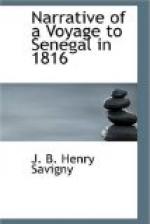The Moors tan skins with the dried pods of the Gummiferous Accia: thus prepared, they are impenetrable to the rain, and it may be affirmed that, for their suppleness, as well as for the brilliancy and finesss of their grain, they might become a valuable fur in Europe, either for use or ornament. The most beautiful of these skins seemed to be those of very young goats, taken from the belly of the dam before the time of gestation is completed. The great numbers of these animals, which are found round all the inhabited places, allow the inhabitants to sacrifice many to this species of luxury, without any extraordiny loss. The cloaks, with a hood, which are mentioned in this memoir, are composed of several of these skins, ingeniously sewed together, with small and very fine seams. These garments, designed as a protection against the cold and the rain, are generally black, but some are also seen of a reddish colour, which are not so beautiful, and heavier these latter are made of the skins of the kind of sheep, known by the name of guinea-sheep, which have hair instead of wool. As for the goldsmiths work, made by these people, it is executed by travelling workmen, who are at the same time armourers, smiths and jewellers. Furnished with a leather bag which is provided with an iron pipe, and filled with air, which they press and fill alternately, by putting it under their thigh, which they keep in constant motion, singing all the while; seated before a little hole dug in the sand, and under the shade of some leaves of the date-tree laid upon their heads, they execute on a little anvil, and with the help of a hammer, and some small iron awls, not only all kinds of repairs necessary to fire-arms, sabres, &c. but manufacture knives and daggers, and also make bracelets, earrings, and necklaces of gold, which they have the art of drawing into very fine wire, and forming into ornaments for women, in a manner which, though it wants taste, makes us admire the skill of the workman, especially when we consider the nature, and the small number of the tools which he employs.
The Moors, like the Mahometan negroes, are for the most part, provided with a larger or smaller number of gris-gris, a kind of talisman consisting in words, or verses copied from the Coran, to which they ascribe the power of securing them against diseases, witchcraft and accidents, and which they buy of their priests or Marabous. Some Spaniards from Teneriffe, who came to Cape Verd, at the time that the French Expedition had taken refuge there, struck us all, by their resemblance with these Africans. It was not only by their brown complexions that they resembled them; but it was also by their long rosaries, twisted in the some manner about their arms, resembling, except the cross, those of the Moors, and by the great number of Amulets, (gris-gris of another kind) which they wear round their necks, and by which they seemed to wish to rival the infidels in credulity. There is then, in the South of Europe, as well as in the North of Africa, a class of men, who would found their authority, upon ignorance, and derive their authority from superstition.




